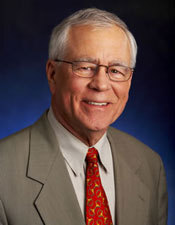Radiologists call for national plan to tackle medical imaging overuse
by
Brendon Nafziger, DOTmed News Associate Editor | August 24, 2010

William R. Hendee
(Image courtesy the
American Association of
Physicists in Medicine)
How are imaging exams like antibiotics? Both might get prescribed too often, ratcheting up health care costs.
Patient demand, lack of guideline awareness and even financial conflicts of interest have contributed to the growth of unnecessary medical imaging, a group of high-profile radiologists argue, and they think the profession should crack down on it.
In an article in the October issue of Radiology, a team of radiologists call for a national strategy to tackle medical imaging overuse, saying educating patients and referring physicians while developing intelligent ordering software could help curb the number of unnecessary studies performed.
The paper sums up the American Board of Radiology Foundation's two-day summit held in Washington, D.C. last August to discuss overuse of medical imaging.
One of the trickiest aspects of the problem is understanding exactly how much of a problem there really is.
"It's hard to get a handle on," William R. Hendee, co-author of the study and professor of radiology, radiation oncology and biophysics at Medical College of Wisconsin in Milwaukee, told DOTmed News.
Because negative findings are useful to rule out pathology and so much of care is personalized, it's tough to determine when an imaging study is truly unnecessary, unless it's obviously redundant - that is, a physician unwittingly orders a duplicate exam.
Still, Hendee said it is generally held that 25 to 50 percent of exams are medically unnecessary.
"But it's a soft number," Hendee acknowledges.
Regardless of the scope, the radiologists say curbing overuse of imaging can help with two important goals: reining in escalating health care costs and allaying fears of medical radiation from imaging creating the very cancer it's meant to discover.
According to the paper, health care spending is currently 16 percent of gross domestic product, but the Congressional Budget Office predicts that at the current rate, in five years it will be one-fifth of the GDP, and almost half by 2082.
While imaging certainly isn't solely to blame for health care's growing bite out of the national budget, its costs have grown at twice the rate of other health care technologies, such as drugs and lab tests, the paper's authors argue.
Perhaps more significantly, medicine is accounting for a growing proportion of the average American's yearly radiation exposure.
In 1980, medical radiation contributed to less than a quarter of the public's radiation exposure, according to the study. Now, it accounts for nearly half. While many of the imaging exams are performed on the elderly, who have less of a risk of dying from slow-growing cancers triggered by radiation exposure, the young are increasingly getting affected, too.
